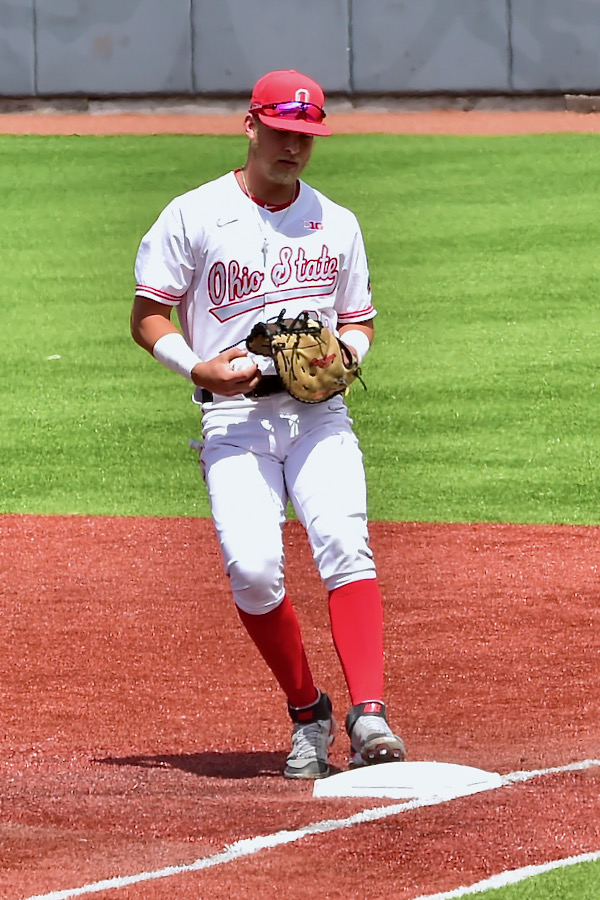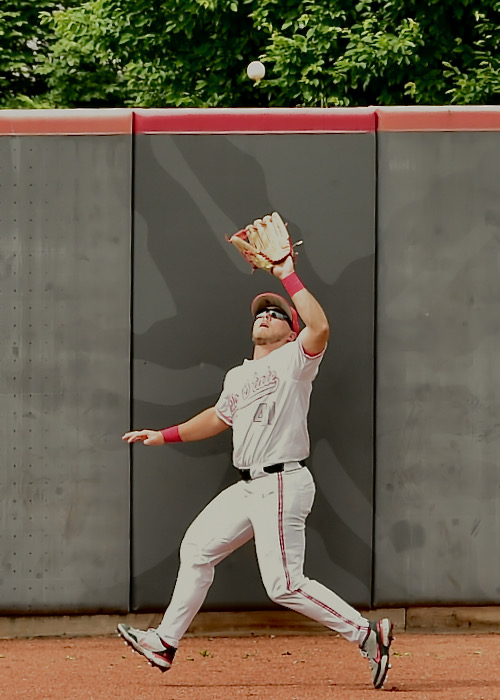This team had more than a few chances to make a run at a post-season berth, but it never got into a rhythm to make a serious run; Now, the work begins to make sure this doesn’t happen next season.
 Columbus – The final day of a college baseball season usually is melancholy, sentimental, upsetting or all of the above unless the team is celebrating a national championship on the infield in Omaha.
Columbus – The final day of a college baseball season usually is melancholy, sentimental, upsetting or all of the above unless the team is celebrating a national championship on the infield in Omaha.
It was that way for Ohio State on a chilly, sun-splashed Sunday afternoon at Bill Davis Stadium.
The players got a brief talk from coach Greg Beals before meeting their families and taking pictures and more pictures.
There was the sight of junior reliever Bayden Root standing on a tarp-covered mound staring at an imaginary sign from the catcher one more time until 2022.
The seniors lugged around picture frames with their game jerseys inside. Then they inscribed their names on a new wall of honor.
The Buckeyes lost 8-2 to Northwestern in a ballgame in which both teams were playing out the string, and the positive takeaway was five seniors, Conner Pohl, Joe Gahm, Patrick Murphy, Scottie Seymour and Jake Vance, received a heartfelt thank you.
Winning two of three games against the Wildcats (15-21) will give the team a little boost going into the off-season.
The fun was supposed to extend beyond the Memorial Day weekend, but Ohio State (22-20) never got into any type of rhythm to scare conference leaders Nebraska, Michigan and Maryland.

Outfielder Mitchell Okuley catches the last out of the 2021 season for the Buckeyes.
“At Ohio State you expect to play for championships and you expect to play in the national tournament,’’ Beals said. “It’s a miss from that standpoint. You thank the seniors and you warn the returners that there is a lot of work to be done.’’
But any observations must come with the reality that COVID-19 protocols made this the most difficult season in history to be a college baseball player.
The Buckeyes had to make bus trips to faraway places such as Greenville, South Carolina, Michigan, Maryland, Rutgers and Indiana spaced out from one another and wearing masks every single minute.
When they were at hotels, players could not mingle and their access to the outside world was limited to perhaps one convenience store if they needed a snack. Meetings were held on Zoom.
The only spectators allowed inside stadiums were family, relatives and friends. The head counts at games were in the hundreds.
Yes, it certainly was a joy for them to play ball after getting in 14 games in 2020, but there was the ever-present virus that could have threatened everything they worked for with just a couple of infections.
“I’m really honest with the guys. I stated facts,’’ Beals said. “I told them that these were the things that we’re being asked to do and these were the things we had to do in order to do what we love to do. You suck it up and do what you need to do.’’
Ohio State lost one series to COVID, and it was because Minnesota had at least one case and cancelled.

Pitcher Jake Vance makes his final appearance for the Buckeyes.
The Buckeyes were able to schedule a make-up game against Purdue, but they finished two games under the 44-game maximum the Big Ten placed on its teams.
Would things have been different had they swept the Gophers and gotten to 26 wins?
Maybe.
Or how about being able to sweep Penn State and Purdue rather than taking two out of three?
That would have gotten them to 28 wins and the NCAA tournament committee would have had to take notice.
The longest winning streaks were three games against Illinois to open the schedule in Greenville, South Carolina, and a five-gamer that included a four-game sweep of Indiana at home.
Otherwise, it was one step forward and too often a couple of steps backward.
The sweep against the Hoosiers was followed by losing two of three at Michigan and being swept at Maryland.
The game that sealed Ohio State’s fate came when it led Nebraska 9-2 going into the seventh inning last Saturday only to lose 11-9 when the bullpen caved in.

The McKinley Funeral Home of Lucasville, Ohio, proudly supports Ohio State Buckeye sports on Press Pros.
“The fact of the matter is there is always a fine line between winning and losing and good seasons,’’ Beals said. “You’re talking three or four games maybe. You can say that not getting in the Minnesota series hurt us. It hurt the flow of our season. That series could have been a real boost. You can’t make excuses for that. We had our chances to win games. Simply, quite honestly, we lost the fine line.’’
Also true is the fact that while this team had stars in first baseman Conner Pohl, shortstop Zach Dezenzo, freshman center fielder Kade Kern and ace pitcher Garrett Burhenn, there were way too many holes to make a run.

Joe Gaum pitches his last game for the Buckeyes.
The bottom four or five spots in the batting order after Kern, Dezenzo, Pohl and catcher-designated hitter Brent Todys had to pedal hard just to stay above the dreaded Mendoza Line.
After Burhenn, no starter was able to consistently give the team a chance to win.
That put a lot of pressure on a bullpen of Root, Joe Gahm, Patrick Murphy and closer TJ Brock that looked to be arm-weary in the closing weeks from having to work too many innings.
Brock saved nine games and, by and large, was a security blanket at the tail end of games.
The holes were immense:
- Opposing teams stole 83 bases in 97 attempts. The next-highest total in the conference was Illinois with 52 allowed.
- The batting order was shut out six times. The hitters ranked 12th overall in the Big Ten and – turn away if you have a weak stomach – 11th in hits, 10th in total bases and ninth in runs in the Big Ten going into the weekend.
- The team average was .247 and only Minnesota at .235 was lower. It had the third-most strikeouts in the conference.
- The defense wasn’t bad, but it did turn a conference-low 20 double plays and had 14 multi-error games.

Scottie Seymour snags a pop-up in left field in his final game for the Buckeyes.
“Obviously the season didn’t go the way that we designed it,’’ Beals said. “With all that being said, I told the guys that I was proud of them. I was proud of them for all the things that they went through this year and their perseverance through it all. While everything around them was changing, the brotherhood of our program didn’t change. They might have even grown this year, and that’s something to build on.’’
What’s next?
Juniors Dezenzo, Burhenn, Brock, Seth Lonsway and Jack Neely could be lost to the Major League Baseball draft that begins July 11 in Atlanta. That would be a torpedo hit.
“You are always looking forward,’’ Beals said. “The season is over and I have to find out how to win the next game. The next step is evaluation, and for me it’s self-evaluation. What do we have to do to do better? The process has already begun. I know the things that we missed this year and the things we have to re-instill in the program. We have a pretty good idea (what we have to do).’’

“While everything around them was changing, the brotherhood of our program didn’t change.’’ – Coach Beals

While they had stars in first baseman Conner Pohl, shortstop Zach Dezenzo, freshman center fielder Kade Kern and ace pitcher Garrett Burhenn, there were way too many holes on this team to make a run. (Press Pros Photos By Julie McMaken Wright)




